Статьи журнала - Журнал стресс-физиологии и биохимии
Все статьи: 984
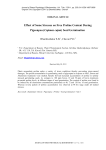
Effect of some stresses on free proline content during pigeonpea (Cajanas cajan) seed germination
Статья научная
Plants accumulate proline under a variety of stress conditions thereby preventing stress-caused damages. The proline accumulation in germinating seeds of pigeonpea in response to NaCl, Boron and Aluminium treatments were studied. Results showed increased accumulation of proline in salinity stressed germinating seeds. As compare to 100 ppm boron, 10 and 50 ppm of boron treatments promoted proline levels at different stages of seed germination. The content of proline was found to be induced by all aluminium concentrations particularly at 48, 72 and 120 hrs. of seed germination. Whereas reverse pattern of proline accumulation was observed at 96 hrs stage under all studied stresses.
Бесплатно
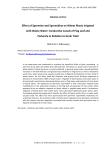
Статья научная
A pot experiment was conducted to evaluate the beneficial effect of grain presoaking in spermine (0.15 mM), spermidine (0.3 mM) and their interaction on waste water tolerance of wheat plants ( Triticum aestivum L.) variety Sakha 94. In general, waste water caused significant increases in the leaf thickness and ground tissue thickness in flag leaves as well as metaxylem vessel area, xylem vessel area, vascular bundle area in flag leaf and peduncle of main shoot of wheat plants. On the other hand leaf thickness and ground tissue thickness appeared to decrease at concentration 100% of waste water. Irrigation of wheat plants with waste water at all examined concentrations decreased phloem area in flag leaves and peduncle of main shoot of wheat plants. The application of spermine, spermidine or their interaction induced some modifications in the anatomical features of the flag leaf and peduncle of main shoot which appeared to be an adaptive response to heavy metals in applied waste water. Furthermore, Irrigation of wheat plants with waste water stress decreased significantly grain yield / plant. The applied polyamines appeared to alleviate the effect of heavy metals stress in waste water on grain yield. The effect was more pronounced with spermine +spermidine treatment. For anatomical features, the economic yield of wheat plants appeared to be positively correlated with the phloem area but negatively correlated with vascular bundle area and xylem area in flag leaf and peduncle of main shoot.
Бесплатно
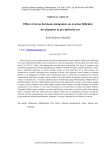
Effect of stress hormone antagonists on ovarian follicular development in pre-pubertal rat
Статья научная
Effect of stress on pre-pubertal ovarian follicular development was studied. Fifteen day old female rats were administered under stress (exposed to maternal separation; 6 hours/day) from post-natal day 15 to 21 for 7 days, and appropriate controls were maintained. The time of exposure was randomly changed every day during light phase (7AM to 7 PM) of the day to avoid habituation. There was a significant decrease in serum estrogen levels on post-natal day 21 in stress group rats compared to controls indicating stress response in these rats. However, mean number of healthy follicles in all categories of follicles were significantly lower in stressed rats compared to controls. Concomitant with these changes, mean number of atreitic follicles showed an increase over control values in stressed rats. In contrast administration of Naltrexone (5µg NTX/rat/day), Mifepristone (1 µg MP/rat/day), FSH (10 IU FSH/rat/day) with stressed the significant increases in the relative weight of ovary, uterus, fallopian tube, body weight and the mean number of healthy follicles in the ovary compared to the controls. In the ovary treatment of stressed did not affect primordial follicles. Primordial follicles were reduced in number significantly in the ovary of controls and treated groups when compared with the initial controls whereas there was no significant variation among the controls and the treated groups. The results indicate that stress dose not interfere with the progress of pre-pubertal follicular development. However, it causes increased loss of follicles by atretia.
Бесплатно
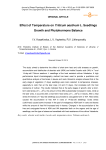
Effect of temperature on Triticum aestivum L. seedlings growth and phytohormone balance
Статья научная
He study aimed to determine the effect of short-term heat and cold stresses on growth, accumulation and distribution of abscisic acid (ABA) and indole-3-acetic acid (IAA) in 7 and 14-day-old Triticum aestivum L. seedlings of the frost resistant cultivar Volodarka. A high performance liquid chromatography method has been used to provide a qualitative and quantitative analysis of hormones in leaves and roots. Biometric analysis showed that at the early stage of vegetation (7 days) seedlings were more resistant to temperature stresses, especially to cold, than at the later ones (14 and 21 days), that correlates with the frost resistance of cultivar. The results indicated that at the early stages of growth, after a short-term cold stress (2 h., +2 0C), the amount of free ABA substantially increased in roots, while at the later ones, it occurred after a short-term heat stress (2 h., +40 0C) in leaves. After a heat stress the leaves of 7-day-old seedlings accumulated a conjugated form of IAA. Heat stress caused the accumulation of free IAA in roots of 14-day-old seedlings. Cross stress (cold+heat) caused some increase in the pool of endogenous ABA both in roots and leaves while the amount of free IAA increased only in leaves. Сhanges in the accumulation of the free and conjugated forms of ABA and IAA depended both on the organs and the age of seedlings, and the type of stress and correlated with frost resistance of the cultivar Volodarka.
Бесплатно
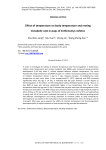
Effect of temperature on body temperature and resting metabolic rate in pups of Eothenomys miletus
Статья научная
In order to investigate the ability of ambient temperature and thermoregulation in Eothenomys miletus, body temperature and resting metabolic rate (RMR) were measured during postnatal development (1-49 day) when E. miletus exposed different ambient temperature. The result showed that: body temperature and RMR of pups in E. miletus increased according to the increase of ambient temperature during 1 day to 7 day, showed character of poikilotherms; body temperature of pups were lower in low temperature(5 oC,10 oC), relatively and RMR increased significantly when day age is 14 day, it indicated that the pups showed a certain degree of thermoregulation in this phase. Its thermoregulation ability developed quickly during 7 day to 14 day. RMR of pups was extreme significantly higher in low temperature than that in other temperature when day age was 21 day, it showed that the pups had some thermoregulation to low temperature stimulation. The RMR of pups was showed increasing trend in high temperature(35 oC) when 28 day; on 35 day and 42 day, the thermal neutral zone were 22.5 to 30 oC and approaching its adult level. All of these results indicated that pups of E. miletus in the different growing period had different thermogenesis and energy allocation to maintain stable to body temperature, thermogenesis was weaker in the early phase of postnatal development, most of energy is used to its growth. After pups were weaned, the ability of constant temperature and thermoregulation developed quickly to adjust variations of environment during postnatal development.
Бесплатно
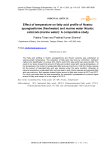
Статья научная
The Fatty acid profiling in Nostoc spongiaeforme and Nostoc calcicola was undertaken at varying growth temperature. The extraction of fatty acid was done by chloroform: methanol method and identification of various SFA, MUFA and PUFA was performed using GC-MS. The result of our study showed that amount of fatty acid content varied with varying temperature. At low temperature, the content of unsaturated fatty acid was maximum in both the Nostoc species but the amount of saturated fatty acid was reduced under the same condition. Whereas, at extreme temperature unsaturated fatty acid was least in both Nostoc species and saturated fatty acid was maximum. Both species showed higher amount of fatty acid content at 20°C and 30°C. Our study concluded that the best temperature for mesophilic cyanobacteria to produce higher amount of fatty acid content is in the range of 20-30°C.
Бесплатно
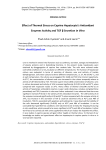
Статья научная
Liver is involved in several vital functions such as synthesis, secretion, storage and metabolism of plasma proteins and in detoxifying functions. In the present study, hepatocytes were obtained by disaggregation of caprine liver caudate lobe. The cells were cultured under controlled conditions in a CO 2 incubator at different temperatures. The function of hepatocyte culture was evaluated in terms of secretion of albumin, urea and acitivity of Lactate dehydrogenase. Cells were cultured at three different temperatures, i.e. 37, 40 and 42 o C, and at each temperature, the culture was propagated for 24,48 and 72h time interval respectively. At 37 oC, the concentration of albumin and urea increased in the culture temporally where as activity of LDH decreased by 72h. The least square mean (LSM) concentration of albumin, urea in culture decreased and activity of LDH increased significantly (PoC, when compared with respective values at 37 oC. Hence effect of thermal stress(40 and 42 oC) on activity of hepatocyte antioxidant enzymes ( super oxide dismutase, catalase and glutathione peroxidase) and TGF β secretion in vitro was further evaluated. It was observed that there was significant increase (PoC when compared with the enzyme activity at 37 oC, but increase in the secretion of TGF β could be observed only at 42 oC post 48h of incubation. TGF β is associated with apoptosis and cytotoxicity. It was observed that viability of the cells decreased significantly (PoC post 48h of incubation. It can be concluded that hyperthermic conditions were observed to be stressful for hepatocytes during in vitro conditions, which proved to be more significant at 42 oC post 48h of incubation. Further work has to be carried out with some supplements which can reduce the hyperthermic effect. In vivo studies in caprine species will give further insight on thermal stress. To the best of our knowledge no studies on hyperthermic effect on hepatocytes in caprine species in vitro or in vivo has been reported.
Бесплатно
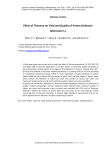
Effect of thiourea on yield and quality of potato ( Solanum tuberosum L.)
Статья научная
A field experiment was carried out to study the effect of five concentrations (0, 250, 500, 750 and 1000 mM) of thiourea application on mother tubers on yield and quality attributes of harvested potato, variety Spunta in the region of Chott-Mariem in Tunisia. Treated tubers (Ø = 50 mm) were planted in field after breaking dormancy at a spacing of 80 cm x 30 cm according to completely randomized design (CRD) in three replications. Quality attributes of potato tubers especially fresh matter and dry matter of plant, total reducing sugars in leaves, tuber yield, number and diameter of tubers per plant and number of sprouts per tuber was measured. Soluble proteins and starch content in potato tubers were also quantified. In general we noted that application of thiourea showed significant influence on yield and on quality of tubers comparing to control. Maximum tuber yield per plant, maximum number of tubers per plant and maximum starch content was recorded with 250 mM of thiourea. Moreover, highest dry matter of potato plant was found also at this concentration. While increasing dose of thiourea thereafter it showed slight significant improvement and do not affect significantly the diameter of tubers comparing to control.
Бесплатно
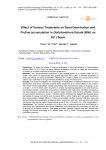
Статья научная
Objectives: To study the effects of various treatments on seed germination of Dolichandrone falcata (Wall. Ex DC.) Seem. by using different substrates; and also, to study the accumulation of proline as a stress response to the given treatments.
Бесплатно
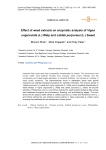
Статья научная
Important field crops grow less successfully contaminated by weeds. The environment and human health have suffered severely from improper weed control methods and the unnecessary and inappropriate application of chemical fertilizers, and caused an increase in weed variety resistance. The phytochemicals found in allelopathic plants have gained importance as potential biological equivalents for synthetic herbicides. The enzyme activity of Lablab purpureus (L.) sweet and Vigna unguiculata (L.) Walp can be impacted allopathically by weed extracts. In Vigna unguiculata (L.) Walp and Lablab purpureus (L.) sweet, the enzyme activities of Phyllanthus niruri (L.) and Chloris barbata Sw. weed extracts treated as foliar sprays were assessed throughout the pre-flowering, flowering, and post-flowering stages. This work shows that an aqueous weed extract of Lablab purpureus (L.) sweet and Phyllanthus niruri (L.) and Chloris barbata Sw. can enhance enzyme activity in Vigna unguiculata (L.) Walp, hence providing the possibilities for the development of plant growth.
Бесплатно
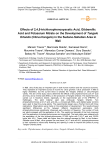
Статья научная
In Mali, citrus fruits play an important part in both human nutrition and the country's economy. They represent an important source of income for citrus growers. Citrus production in Mali is highly diversified, but the current trend is towards the Tangelo Orlando or Citrus×tangelo variety. The aim of this study was to determine the effects of two phytohormones (2,4,5-T acid and AG3) and a mineral salt (KNO3) on the production of Tangelo Orlando. The experiment was carried out in Koulikoro district, especially on the experimental plot of the IPR/IFRA of Katibougou. The plant material used was white-pulp Tangelo Orlando. Two phytophytohormones (2,4,5-T acid, and AG3), a mineral salt (KNO3) and distilled water (control) were used to treat the young plants. The experimental design was a Fischer block with three replications. Observations were made on the parameters of development. The results showed significant differences (p
Бесплатно
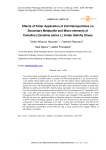
Статья научная
The present study investigated the biochemical impact of ZnO nanoparticles (NPs) and salinity stress in Camelina (Camelina sativa L.) plants. ZnO NPs were applied at 0, 20, 40 and 80 mgL-1 and salinity stress (NaCl) were at 0, 50, and 100 mM. Salinity stress significantly enhanced total phenolic compounds, anthocyanin, carotenoid and ability to scavenge the DPPH radical in shoots and roots. We demonstrate that the ZnO NPs, plant carotenoid content is profoundly affected by salinity and ZnO NPs. Salinity stress decreased zinc concentration in shoots and root, but increased macro-element such as calcium (Ca) and phosphorous (P). Application of 20 mgL-1 ZnO NPs gave the most impact contents of calcium (Ca), phosphorous (P). With increasing ZnO NPs concentration, zinc (Zn) content was increased. Foliar application of ZnO NPs did not show any significant effect on flavonoid content in Camelina but caused increases in DPPH radical scavenging capacity in shoot and root. We found that the amount of phenolic compounds in shoot was decreased at 20 mgL-1 of ZnO NPs concentration. ZnO NPs at 20 mgL-1 was more provocative to reduce the effects of NaCl. Therefore, the results suggest that the appropriate concentration of ZnO NPs (20 mgL-1) could overcome the negative effects of salt stress in Camelina.
Бесплатно
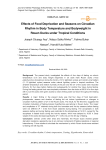
Статья научная
Background: The present study investigated the effects of four days of fasting on colonic temperature (CT) and body weight responses in 20 adult male Rouen ducks (Anas platyrhynchos domesticus) during the hot-dry (12:12 light/dark cycles) and cold-dry (harmattan) (11:13 light/dark cycles) seasons under natural light/day cycles in tropical conditions. The ambient temperature and relative humidity of the pen and the CT of the ducks were recorded bihourly for four days before fasting and subsequently for another four days during fasting. During the fasting period food was completely withdrawn from the ducks at 06:00 h for four days (96 h), but the ducks were given access to clean drinking water ad libitum throughout the fasting period. Results: A major finding in the present study was that four days of food deprivation, photoperiods, season and duration of fasting did not induce hypothermia or changes in circadian rhythmic pattern of CT in the Rouen ducks. The result, for the first time, suggests that circadian modulation of fasting-induced hypothermia was lacking in Rouen ducks. The mesor and amplitudes of CT obtained during both the harmattan and hot-dry seasons before fasting were not different (P > 0.05) from those obtained during fasting. The acrophases in both seasons before and during fasting were restricted to the photophase at 14:00 h, except for the acrophase in fasted ducks during the hot-dry season, which was delayed to 16:00 h. Body weight of the ducks decrease significantly (P > 0.05) only on the 4th day of fasting. Conclusion: Overall, unlike other birds and mammals, the Rouen ducks showed greater starvation resilience, apparently due to an unknown component of fasting resistance or regional heterothermy. Future studies to elucidate the mechanism by which Rouen ducks were resistant to fasting are still required.
Бесплатно
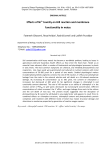
Effects of Ni2+ toxicity on hill reaction and membrane functionality in maize
Статья научная
Soil contamination with heavy metals has become a worldwide problem, leading to losses in agricultural yield and hazardous health effects as they enter the food chain. Nickel as an essential trace element, affect a number of biochemical and physiological processes in plants in toxic levels. The most common symptoms are chlorosis, and inhibited photosynthesis and respiration. Zea mays seeds were germinated and cultured on nutrient solution with nickel concentrations of 50-200 μmol for a period of two weeks. Studied physiological makers included photosynthetic pigments content, the rate of Hill reaction, K+ efflux and carbohydrate leakage from the roots to the external solution and cell death as a Ni-induced membrane damage. By increasing Ni concentration up to 100 μmol, the content of chlorophyll a increased, but decreased at 200 μmol Ni. No significant changes in chlorophyll b and carotinoids content observed. The rate of Hill reaction as an ability of chlorophyll a in the reaction center of PSII680 to split water, decreased by increasing Ni concentration. Different concentrations of nickel increased the K+ efflux and sugar leakage from roots to the culture and the cell death of root tips. The present results suggested that the disruption of photosynthesis by Ni cannot be attributed to any single factor and appears to result from its combined effects on chloroplast structure, chlorophyll content and photosynthetic protein complexes and treatment with different levels of nickel may induce structural damage and alterations in membrane properties by generation of reactive oxygen species.
Бесплатно
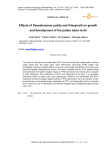
Effects of Pseudomonas putida and Vitazyme® on growth and development of the potato tuber moth
Статья научная
The ability of Pseudomonas putida strain BTP1 and the biostimulant (Vitazyme®) to protect potato plants from the potato tuber moth Phthorimaea operculella (PTM) (Zeller) was investigated. Significant negative effects on survival, pupal weight, and fertility of the insect were observed between treatments and control. The results revealed that the BTP1-treated foliage had significantly the highest negative impact on PTM development and reproduction compared to other treatments. The combination of BTP1 and Vitazym® did not result in a synergistic detrimental effect on potato tuber moth reproduction. However, the biostimulant and BTP1 treatments showed the largest negative effects on PTM reproduction due to the density of hairs and trichomes on the treated foliage. Application of BTP1 and Vitazyme® could be a potential tool to reduce the use of insecticides and enhance integrated pest management against potato tuber moth.
Бесплатно
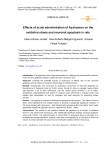
Effects of acute administration of ayahuasca on the oxidative stress and neuronal apoptosis in rats
Статья научная
Introduction: The ayahuasca have legal authorization for religious use and scientific research. There are few published studies to determine their neurotoxic risk.
Бесплатно
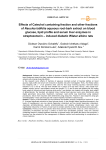
Статья научная
Background. Diabetes mellitus has been a menace to healthy human condition from antiquity. There has been continuous search for plant medicinal substances for drug development with an aim to managing this ailment with minimal drug side effects. In this research work, effects of fractions of aqueous root-bark extract of Nauclea latifolia on blood glucose, lipid profile and serum liver enzymes in diabetic rats were investigated. Thirty -five Wistar albino rats weighing 164.1 - 171.6 grammes were used for this study involving aqueous root-bark extract fractions A, B, C and D. The rats were divided into 7 groups of 5 rats each. Group 1 was normal non-diabetic control, group 2 was diabetic control and groups 3, 4, 5 and 6 were rats treated with 250 mg/kg body weight of varying root-bark fractions while group 7 was diabetic rats treated with 5mg/kg. body weight of glibenclamide, the standard anti-diabetic drug. Fasting blood glucose levels were determined using digital glucometer (Acuu-chek, Mannheim, Germany). Lipid profile was determined using standard procedures. Serum liver enzymes were determined using assay kits. Fraction A was analyzed using gas chromatography- mass spectroscopy and nuclear magnetic resonance spectroscopy.
Бесплатно
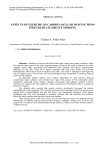
Effects of exercise on cardiovascular dysfunctions induced by cigarette smoking
Статья научная
Abstract - Smoking is known to adversely affect many organs and systems in human, where the cardiovascular system is one of the important targets. However, the exact mechanisms by which cigarette smoke alters myocardial and endothelial cells function and induces cardiovascular pathology are not clear. There are no reports especially with nitric oxide (NO), uric acid and hemodynamics after acute exercise in smokers up to date. This study is designed to investigate the role of oxidative stress, NO and uric acid in the pathophysiologic mechanisms of smoking- induced cardiovascular diseases. 40 apparently healthy subjects were studied. Depending on their previous physical conditioning status subjects were divided into equal four groups (n=10), physically active nonsmokers, physically active smokers, sedentary nonsmokers and sedentary smokers. Exercise tolerance was evaluated for each subject by using a running race (3 kilometers) after a worming up period of 5 minutes. The obtained data revealed that regular exercise significantly decreased the plasma malonaldehyde, total cholesterol, LDL and uric acid levels below sedentary levels. Pre and post race plasma level of malonaldehyde and uric acid levels were significantly increased, while, plasma glutathione and NO were decreased in sedentary smokers than the sedentary non smokers, physically active smokers and physically active non smokers. These findings point to the role of NO, uric acid and lipid peroxide in the pathophysiologic mechanisms of smoking induced cardiovascular diseases. Sedentary smokers may be at an even greater risk of oxidative stress-related cardiovascular diseases. Finally, every body should include in a regular exercise.
Бесплатно
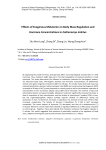
Статья научная
By regulating the pineal hormone, photoperiods affect many physiological characteristics in small mammals. Thus, melatonin might take part in the thermoregulation of seasonal variations in small mammals. This study determined the influence of melatonin treatment on thermogenic pattern, we measured body mass, thermogenic activities and hormone concentrations of Eothenomys miletus were given exogenous melatonin (MLT) for 28 days. The results shown that body mass was reduced significantly, whereas resting metabolic rate (RMR) and nonshivering thermogenesis (NST) increased at 28 days in MLT group compared to control group as well as the oxidative capacities of mitochondria in liver and brown adipose tissue (BAT) were enhanced; the contents of total and mitochodrial protein increased markedly. Melatonin treatment significantly increased the State 3, State 4 respiration of liver mitochondria, and the activity of cytochrome C oxidase (COX) in liver; but the α-glerocephasphate oxidase (α-PGO) capacity showed no differences during the acclimation in liver. Furthermore, the State 4 respiration, the activities of COX and α-PGO in BAT increased, respectively. The activity of thyroxin 5’-deiodinase (T 4 5’-DII) in BAT increased remarkably. The serum content of thyroxine (T 4) decreased, and that of tri-iodothyronine (T 3) increased. Moreover, serum leptin levels showed no significant differences in MLT group compared to control group. Together, these data indicate that melatonin enhances thermogenic capacity in E. miletus. Our results suggested that melatonin is potentially involved in the regulation of body mass, adaptive thermogenic capacity and hormone concentrations in E. miletus.
Бесплатно
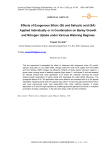
Статья научная
This pot experiment investigated the effect of treatment with exogenous silicic (Si) and/or salicylic acids (SA) on dry matter (DM), nitrogen yield (NY) and soil N uptake from soil (Ndfs) and from fertilizer (Ndff) nitrogen use efficiency (%NUE) of barley plants ( Hordeum vulgare L.) grown under varying levels of watering regimes (high stress I1, mild stress I2 and well-watered I3). Results showed that, foliar application of Si and/or SA markedly improved the overall studied growth parameters of barley plants and decreased the water-deficit influences. The synergistic effects of Si + SA application were more effective as compared with Si or SA applied separately indicating that Si and SA supports each other’s in improving plant performance which was more pronounced under high water-deficit than other watering regimes. A proper application of Si and SA might represent a suitable agricultural approach and result in increased production of barley, particularly, in the semi-arid areas under rain-fed conditions.
Бесплатно

